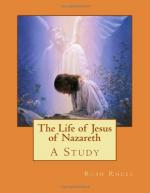4. The most important treatment of the subject is the article JESUS CHRIST by William Sanday in the Hastings Bible Dictionary (1899). It is of the highest value, discussing the subject topically with great clearness and with a rare combination of learning and common sense. S. T. Andrews, The Life of Our Lord (2d ed. 1892), is a thorough and very useful study of the gospels, considering minutely all questions of chronology, harmony, and geography. It presents the different views with fairness, and offers conservative conclusions. G. H. Gilbert, The Student’s Life of Jesus (1896), is complete in plan and careful in treatment, while being very concise. Dr. Gilbert faces the problems of the subject frankly, and his treatment is scholarly and reverent. James Stalker, The Life of Jesus Christ (1880), is a short work whose value lies in the good conception which it gives of the ministry of Jesus viewed as a whole. In simplicity, insight, and clearness the book is a classic, though now somewhat out of date. Studies in the Life of Christ, by A.M. Fairbairn (1882), is of great value for the topics considered. The title indicates that the treatment is fragmentary. The long treatises of Farrar (1875, 2 vols.) and Geikie (1877, 2 vols.) are useful as commentaries on the words and works of Jesus. Farrar often interprets most helpfully the essence of an incident, and Geikie furnishes a mass of illustrative material from rabbinic sources, though with less criticism than even Edersheim has used. Neither of these works, however, deals with the fundamental problems of the composition of the gospels, nor are they satisfactory on other perplexing questions, for example, the miraculous birth.
5. The most important accessory for the study of the life of Jesus is Emil Schuerer, Geschichte des Juedischen Volkes im Zeitalter Jesu Christi (2d ed. 1886, 1890, 2 vols. A 3d ed. of 2d part in 2 vols., 1898), translated, A History of the Jewish People in the Time of Jesus Christ (1885-6, 5 vols.). The political history of the Jews from 175 B.C. to 135 A.D., and the intellectual and religious life of the times in which Jesus lived, with the Jewish literature of Palestine and the dispersion, are all treated with thoroughness and masterful learning. W. Baldensperger, Das Selbstbewusstsein Jesu im Lichte der messianischen Hoffnungen seiner Zeit (2d ed. 1892), furnishes in the first part a survey of the Messianic hopes of the Jews which is in many respects the most satisfactory account that is accessible. The second part discusses the problem of Jesus’ conception of himself in a reverent and learned way. George Adam Smith, The Historical Geography of the Holy Land (1894), is indispensable for the study of the physical features of the land as they bear on its history, and on the work of Jesus. The maps are the best that have yet appeared.




